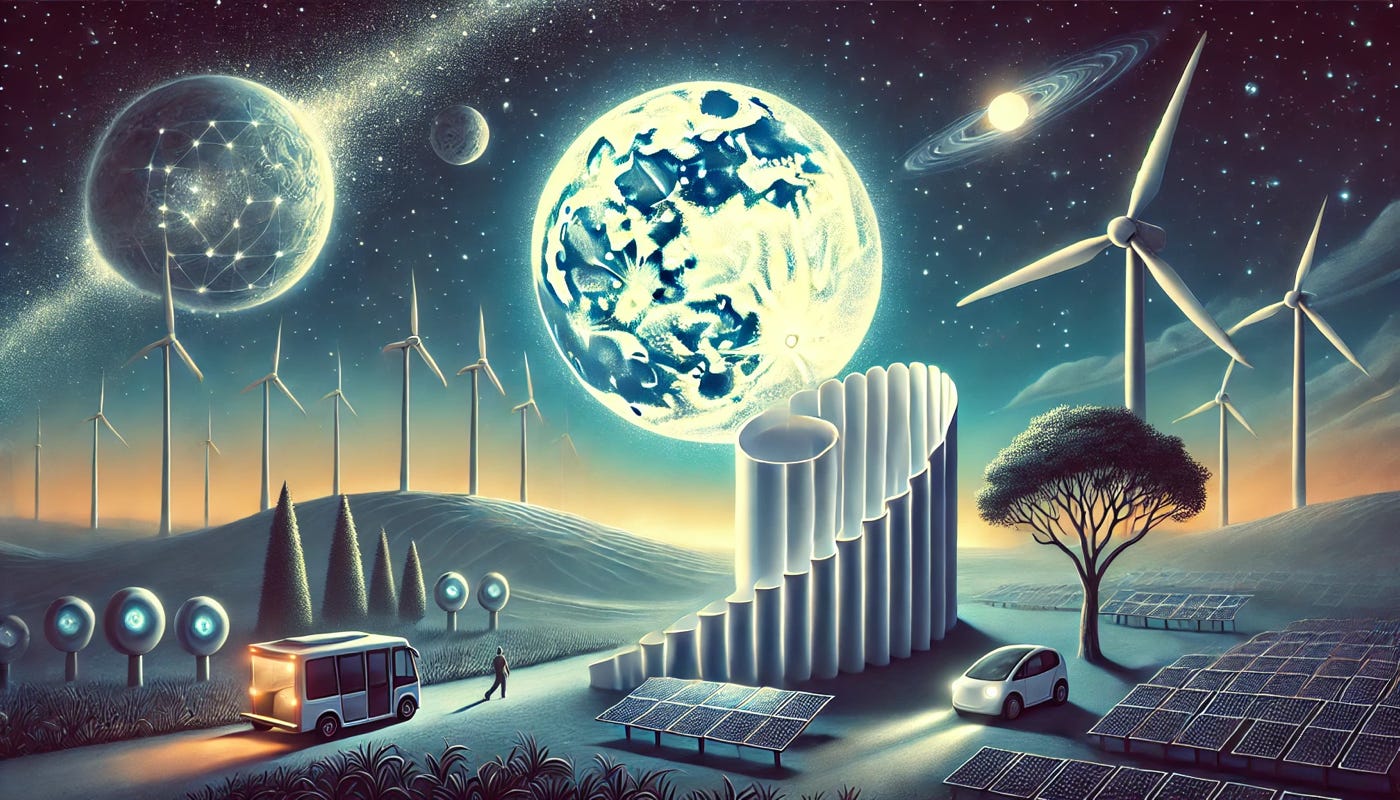Introduction
The climate crisis is not an unsolvable problem looming over humanity—it is a challenge we have already overcome technologically. Renewable energy, precision fermentation, and autonomous electric vehicles are not futuristic concepts; they are present realities poised to revolutionize our world. Yet, despite these advancements, we remain shackled by linear thinking that hinders the rapid adoption of solutions that could usher in an era of sustainability and abundance. This essay boldly asserts that the primary barrier to resolving the climate crisis is not technological capability but our inability to comprehend and act upon exponential growth trends. By breaking free from this outdated mindset, we can accelerate the transformation of energy, transportation, and agriculture, effectively solving the climate crisis and enhancing global well-being
.
The Fallacy of Linear Thinking in an Exponential Age
Linear thinking assumes change occurs at a constant, predictable rate. This perspective might have sufficed in a bygone era but is dangerously obsolete in today’s exponentially evolving technological landscape. Our failure to grasp exponential growth leads to gross underestimations of how quickly and profoundly change can occur.
The Folding Paper Analogy: A Wake-Up Call
To illustrate the power of exponential growth, consider the folding paper analogy:
Exponential Reality: If you fold a 0.1 mm-thick paper 42 times, its thickness would reach the moon—approximately 384,400 kilometers away1.
Linear Misconception: Linear intuition might suggest the paper would only become a modest stack, highlighting how our instincts can mislead us in exponential contexts.
This analogy serves as a stark reminder that exponential growth can lead to outcomes far beyond our linear expectations, underscoring the urgent need to adjust our thinking.
Precision Fermentation: Disrupting Agriculture and Solving Food Sustainability
Precision fermentation (PF) exemplifies how exponential technologies can disrupt entire industries and address global challenges.
Technological Breakthrough: PF uses microorganisms to produce proteins and enzymes traditionally sourced from animals, enabling the creation of dairy and meat alternatives without livestock2.
Exponential Cost Decline:
2000: PF protein production cost around $1 million per kilogram3.
2020: Costs plummeted to approximately $100 per kilogram.
2025 Projection: Expected to drop to $10 per kilogram or less, reaching cost parity with animal proteins4.
Disruption of Traditional Farming:
PF is set to outcompete animal agriculture on cost, efficiency, and sustainability. This will render debates about livestock farming practices and their environmental impact increasingly irrelevant.
Renewable Energy and Energy Storage: The End of Fossil Fuels
Renewable energy technologies have already solved the problem of sustainable power generation.
Solar and Wind Power:
Cost Decline: The cost of solar PV has decreased by 99% since 19765. Wind energy costs have similarly fallen.
Capacity Growth: Exponential increases in installed capacity globally.
Energy Storage:
Battery Advancements: Lithium-ion battery costs have dropped by 89% from 2010 to 20206.
Grid Parity: Combining renewables with storage now competes favourably with fossil fuel power plants.
Implication: The energy sector is on an unstoppable trajectory toward 100% renewable energy, making fossil fuels obsolete.
Autonomous Electric Vehicles: Revolutionising Transportation
Transportation is undergoing a seismic shift that will solve many environmental and urban challenges.
Full Self-Driving (FSD) Technology: Companies like Tesla and Waymo are deploying autonomous vehicles that are becoming safer and more efficient than human drivers7.
Electric Vehicles (EVs):
Cost Decline: Battery cost reductions are making EVs cheaper than internal combustion engine vehicles8.
Performance Improvements: EVs offer superior performance and lower maintenance costs.
Transportation-as-a-Service (TaaS):
Economic Incentive: Autonomous EVs will enable TaaS models that are significantly cheaper than owning a car.
Urban Transformation: Reduced need for parking spaces and less traffic congestion.
Environmental Impact: Transitioning to autonomous EVs will drastically cut greenhouse gas emissions from the transportation sector.
The Climate Crisis Is Technologically Solved
The technologies required to mitigate climate change are not distant possibilities—they exist today and are improving exponentially.
Emission Reductions: Adoption of renewables, PF, and EVs can reduce global greenhouse gas emissions to meet and exceed climate targets.
Economic Benefits: These technologies are not only environmentally beneficial but also economically superior, offering cost savings and new job opportunities.
The Real Obstacle: Our Linear Mindset
Despite the clear evidence and availability of solutions, our linear mindset is the primary barrier to rapid adoption.
Policy Paralysis:
Policymakers continue to debate incremental changes rather than embracing exponential solutions. Investments persist in fossil fuels and traditional agriculture, ignoring their impending obsolescence.
Outdated Urban Planning:
Cities are still designed around personal car ownership and fossil fuel infrastructure. This leads to traffic congestion, pollution, and inefficient use of space.
Misguided Debates:
Public discourse focuses on short-term fixes and marginal improvements. This distracts from implementing transformative technologies that can solve core problems.
Breaking Free: Embracing Exponential Thinking for a Sustainable Future
To unlock the full potential of these technological solutions, we must shift our mindset.
Adopt Exponential Thinking:
Recognise that change can and will happen rapidly once it reaches a tipping point. Plan for futures that may seem radical by today’s standards but are imminent.
Accelerate Policy Changes:
Implement policies that favour exponential technologies, such as subsidies for renewables and EVs, and regulations that phase out unsustainable practices. Redirect investments from obsolete industries to future-proof sectors.
Redesign Education and Communication:
Educate the public and stakeholders about exponential trends and their implications. Foster a culture that embraces innovation and rapid change.
Conclusion
The climate crisis is a solved problem from a technological standpoint. Renewable energy, precision fermentation, and autonomous electric vehicles offer clear, economically viable pathways to a sustainable and abundant future. The only thing holding us back is our outdated, linear mindset. By continuing to think linearly, we waste time on debates and policies that delay progress and prolong environmental degradation.
It’s time to embrace exponential thinking, recognize the transformative power of emerging technologies, and act decisively. The solutions are at our fingertips; unleashing their full potential requires a bold shift in perspective and a commitment to rapid implementation. By doing so, we not only address the climate crisis but also pave the way for a brighter, more prosperous future for all.
Call to Action
We stand at a pivotal moment in history. The technologies capable of solving our most pressing challenges are not just theoretical—they are here and advancing rapidly. It’s imperative for policymakers, business leaders, and individuals to:
Reimagine the Future: Let go of outdated models and envision a world transformed by exponential technologies.
Act Decisively: Accelerate the adoption of solutions that are already proving their worth.
Educate and Inspire: Spread awareness of exponential trends to build collective momentum toward change.
By breaking free from linear constraints, we can unleash the full power of human innovation to not only solve the climate crisis but to create a world of unprecedented opportunity and well-being.
National Aeronautics and Space Administration. “Moon Fact Sheet.” NASA, 2020.
Stephens, N., et al. “Bringing cultured meat to market: Technical, socio-political, and regulatory challenges in cellular agriculture.” Trends in Food Science & Technology, vol. 78, 2018, pp. 155–166.
Tubb, C., & Seba, T. Rethinking Food and Agriculture 2020–2030. RethinkX, 2019, p. 33.
Ibid., pp. 34–35.
International Renewable Energy Agency. “Renewable Power Generation Costs in 2020.” IRENA, 2021.
BloombergNEF. “Battery Pack Prices Fall as Market Ramps Up with Market Average at $156/kWh in 2019.” BNEF, 2019.
International Energy Agency. “Global EV Outlook 2020.” IEA, 2020.












Share this post